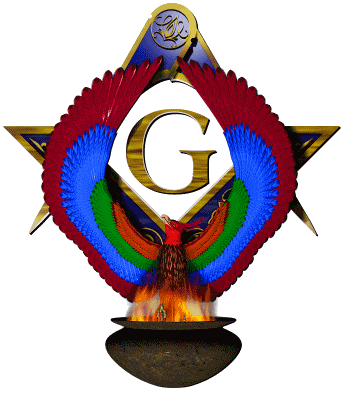Masonic
Tarot Card Deck
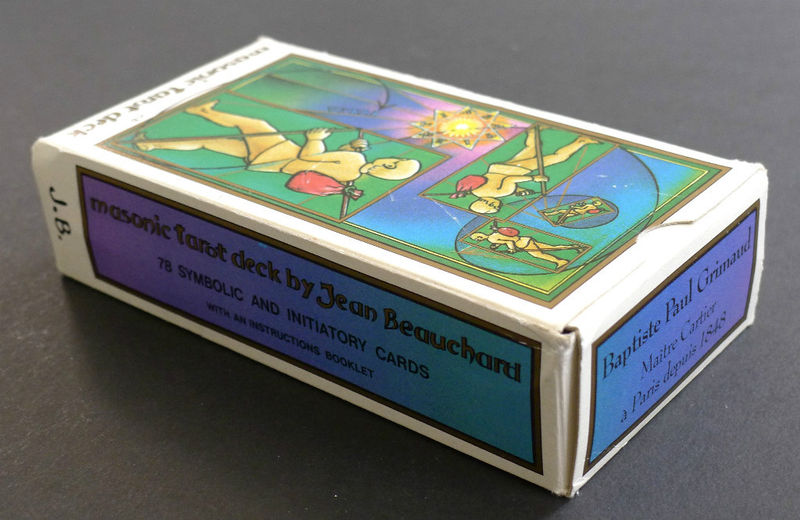
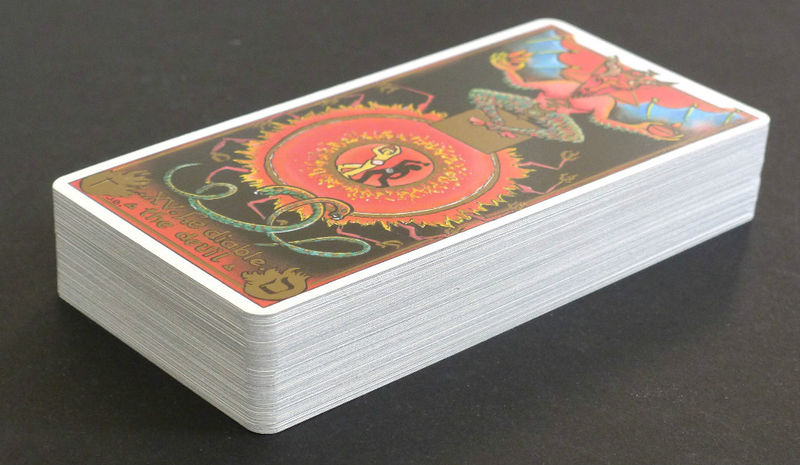
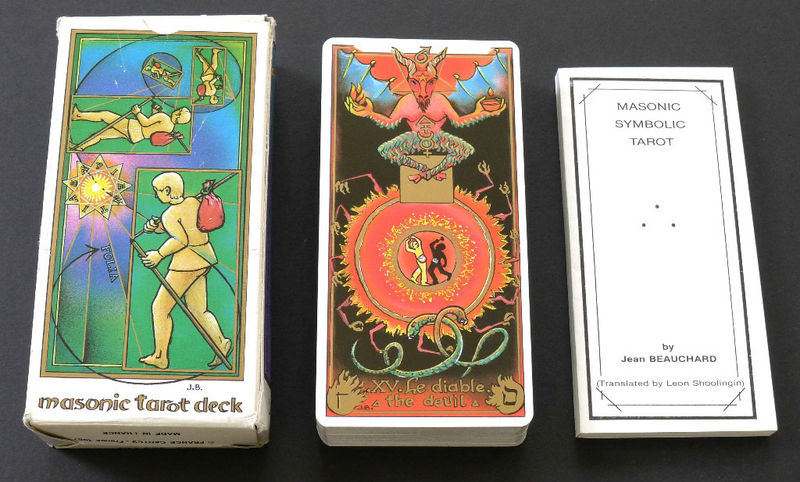
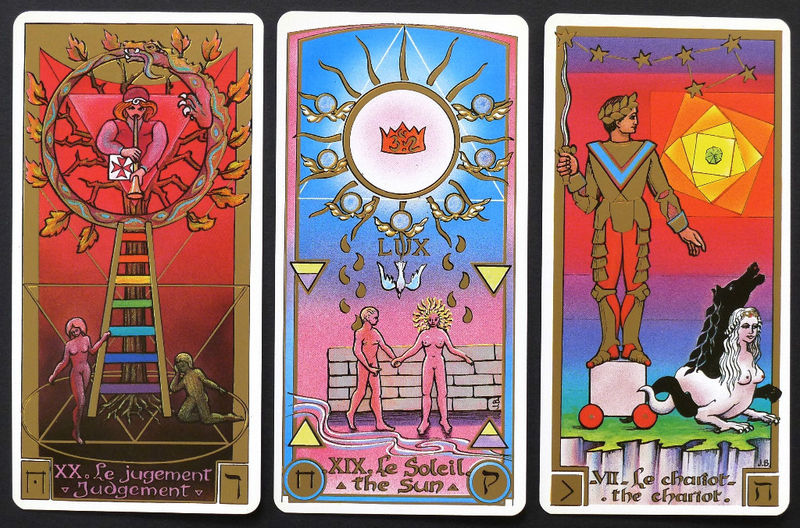
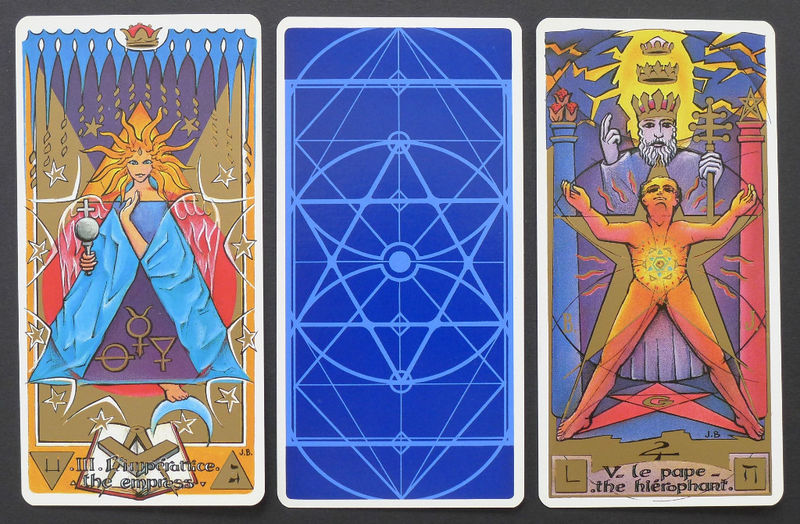
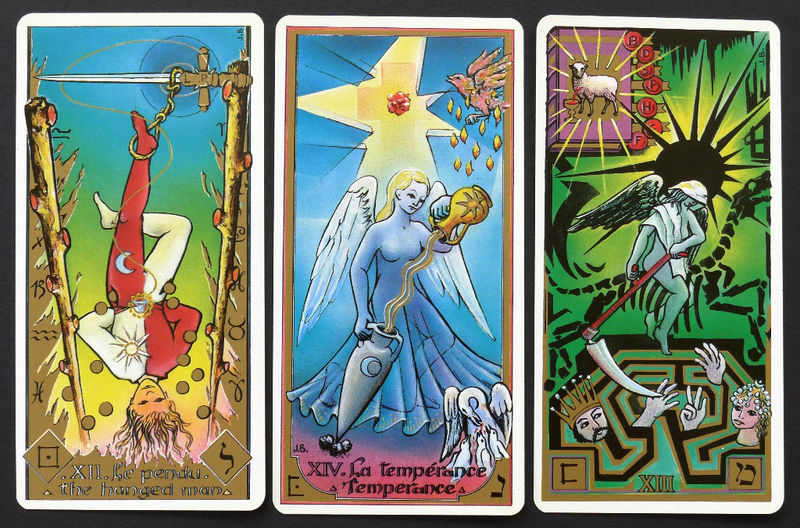
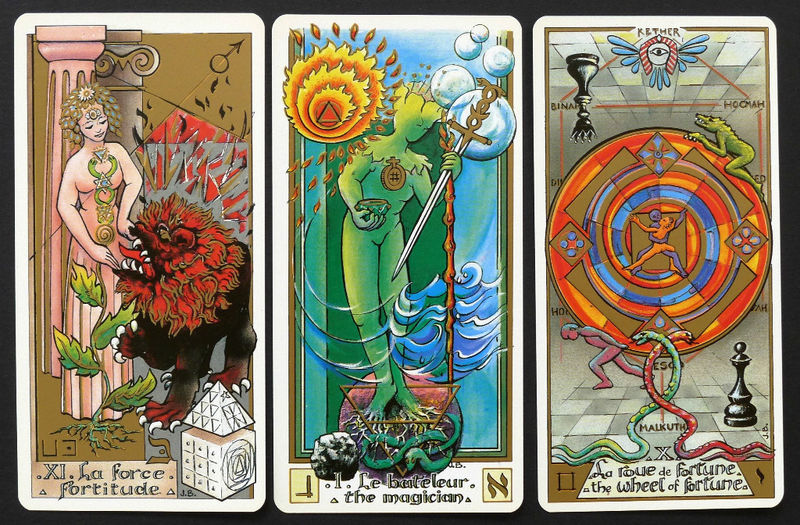
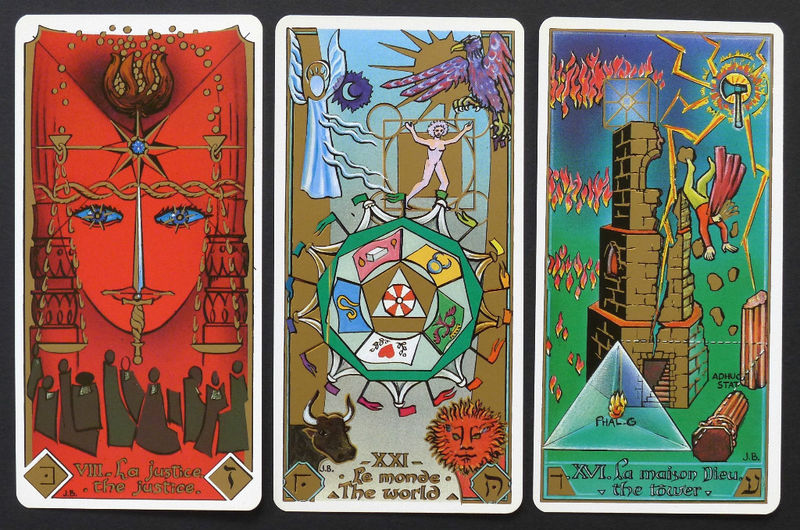
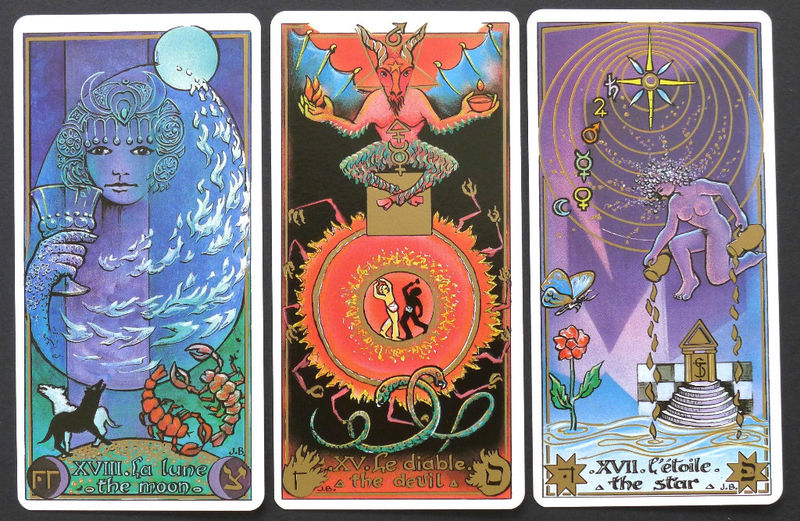
Masonic Tarot Deck by
Jean Beauchard. They were published
by Grimaud © 1987 France. They were purchased brand new, still in
original shrink-wrap. The deck includes 78 cards and instruction book in
French, English and German. The colors are fantastic and they measure 6
inches by 3 inches.
Note:
Nowhere in Freemasonry does the Craft practice or approve of this form of
mysticism. This tarot card deck originates strictly from the imagination
of its creator.

THE
MASONIC TAROT
(A
HISTORY)
A paper prepared for
Lyceum Lodge of Research No 8682 E.C.
by
W/Bro P.C. BROWNE
Civil Service Lodge No 3118 E.C.
17th June 1998
The speculations
over the origins of the Tarot are as varied and diverse as those proposed for
Freemasonry. Yet interestingly the chronological, geographical and
theosophical sources proposed for the Tarot's origin seem to run in tandem
with the theories on the origins of Freemasonry. The author of Tarot
Symbolique Maconnique, Jean Beauchard concurs with this, stating that, "
The origins of the Tarot, as for those of Freemasonry, are to be found (or
lost) in the domain of myths and legends at the dawn of our civilisation;
their evolution participates, in any case, in what is called Tradition"(1). Is
it possible therefore that they have the same origin, or are they both, as
many would argue, merely some of the surviving parts of the plethora of occult
polemics that are part of man's historical religious baggage?
I would however
first like to clarify that in my opinion divination (fortune telling) forms
only a minor part of the Tarot's function, and indeed is it's lowest aspect.
Fortune telling has done great harm to the image of the Tarot, principally due
to the many charlatans and confidence tricksters who have seen fit to hijack
it for their own ends. I hope to show that like Freemasonry it has much to
teach and is in the same way much maligned by certain sectors of society.
Indeed there may lie our first clue as to the common ancestry of the Tarot and
Freemasonry.
I would further
state that the link as I see it, between the Tarot and Freemasonry hinges on
their common connection with Kabbalism. I firmly believe that Brother F. de P.
Castells has proved beyond any reasonable doubt in his numerous books on the
subject, that Freemasonry contains within it's rituals a modernised form of
the ancient Kabbalistic teachings. (2)
Also it should be
noted that two of the two most prolific and respected writers on the more
occult aspect of the Craft, Brothers A.E. Waite and Manly P. Hall both accept
that the Tarot is firmly entrenched in Freemasonry. Indeed the famous Rider
Waite Tarot Pack compiled by our brother is generally regarded as the
bench-mark pack against which to judge all others, and is of course full of
Masonic symbology. It must be stressed though that both these brethren were
involved in sects outside of Freemasonry, and were as such lifelong seekers of
the great esoteric truth. Therefore we must always be aware that Freemasonry
may not have been regarded in their lives as being any more significant than
their other occult
associations.
One of the most
influential and informed accounts on the origins of the Tarot is generally
accepted to be our learned Brother Hall's essay entitled The Tarot. In
this work he traces the first recorded pack back to 1485 in Italy, this being
the Mantegna deck (3), where he tells us that "...the Cabalistic (sic)
significance of these cards is apparent". (4). This pack consisting of fifty
subjects in numerical order, and being he tells us ".... ascribed to
Botticelli and Baldini."(5), but it is not however in the format as we know it
today. It does contain however about 12 cards that bear a definite resemblance
to their current major arcana equivalents (6). Bro. Hall tells us that no
genuine evidence concerning the Tarot is to be found before the Middle Ages,
and it was not ".... until Court de Gebelin projected them into fame."(7) in
1781 that the art escalated. He notes that "Court de Gebelin was a man of
unimpeachable
(1) J. Beauchard,
Tarot Symbolique Maconnique, France Cartes, Paris, 1989, p.4.
(2) F de P.
Castells, Antiquity of the Holy Royal Arch, A. Lewis, London, 1927.
(3) M.P. Hall,
The Tarot, P.R.S., Los Angeles, 1978, p.22.
(4) M.P. Hall,
The Tarot....ibid., p.22.
(5) ibid., p.22.
(6) S. Kaplan,
Encyclopaedia of the Tarot Vol. 1, U.S.Games Systems Inc, New York,
1978, p.40.
(7) M.P. Hall,
The Tarot....ibid., p.15.
1
integrity, an eminent scholar of his day, and a high
Freemason of the Grand
Orient of France."(8) This is of course also the same time period beyond which
Freemasonry starts to become a subjective affair. However like Freemasonry the
logical supposition that nothing so well organised in structure could be
developed out of thin air also applies. Bro. Hall says of the Tarot that "The
mathematical formulas involved in the organisation.... belie the probability
of an accidental origin". (9) With regard to the rich symbolism in the Tarot,
much of it overtly Masonic, he says the following. "Where, we may ask did the
designers of the ancient or original Tarot secure the mass of symbolism which
has led men to attribute so great an age to the designs?.....Is the medieval
Tarot possibly a product of the craftsmen of the Freemasonic Order and
enriched with the archaic symbolism so abundantly apparent in the rituals and
the trestleboard?"(10)
Interestingly the
Tarot and Freemasonry are linked again through their association with the
Knights Templar. According to Mrs John King Van Rensselaer the Devil's
Picture Book was brought back from the crusades by them ".... because they
realised that all the Knowledge of the ages was epitomised in this little
loose leaf picture book."(11) The theory that Freemasonry as an organisation
evolved from the murder of Jacques de Molay and the suppression of Templar
knowledge, is convincingly argued in John Robinson's book Born in Blood
(12), and supported by Brother Pike in his book Morals & Dogma (13).
But this is a separate subject in it's self.
A further
coincidence is that the oldest surviving complete pack in the modern format is
dated at 1718 by Naomi Ozaniec (14), that being the Marseilles Pack .
This of course is coincidentally only one year after the founding of the
United Grand Lodge in 1717. It is interesting that two ancient forms of
esoteric study and practice should emerge to public view the same time. This
would not however be as unusual as it first appears if the two were tied in
some way and formed part of a natural paradigm shift in human spiritual
consciousness. Yet again we see as in many aspects of Freemasonry, that whilst
the historical path is distinctly broken at numerous irregular intervals, the
closing of one era dovetails with the opening of another, as if there is a
perpetual metamorphosis of knowledge right from the very beginning of time.
There is however
obviously a problem with the dating of anything as ephemeral as a pasteboard
card, particularly one that is found in so many countries and has developed
stylistically over the years, as has the Tarot. Further we must also consider
if the surviving examples we have, particularly the uncut fragments, are
actually of the highest quality and purest form? Or could they be merely
rejects or cheap copies of the real system? It is the opinion of Stuart Kaplan
that the early examples of the Marseilles Pack fragments can be dated as far
back as the late 15th to early 16th centuries (15). This of course would
negate Ozaniec's date mentioned earlier.
With regard to Stuart S.
Kaplan's huge volumes of work entitled Encyclopaedia of the Tarot vols.
1,2, & 3. It is my contention that this is not an encyclopaedia at all,
but rather a huge
(8) Ibid. p.16.
(9) Ibid. p.15.
(10) Ibid. p.14.
(11) Ibid. p.6.
(12) J.J.
Robinson, Born in Blood, Arrow Books, London, 1993.
(13) A. Pike,
Morals & Dogma, L.A. Jenkins, Richmond Va, 1917.
(14) N. Ozaniec,
Tarot, Element, Shaftsbury, 1994, p.5.
(15) S. Kaplan,
Encyclopaedia of the Tarot Vol. 2, U.S.Games Systems Inc, N.Y., 1986,
p.270.
2
compendium and source book, that looks at issues
historically and pictorially, and side-steps the esoteric issues. If the
subject matter where of a secular nature this would be no real problem, but
the Tarot is distinctly and overtly esoteric and occult, as is Freemasonry. It
is interesting that whilst he gives much space in his books to the Freemasons
who have been associated with the Tarot, and are indeed it's most prestigious
exponents like Court de Gebelin, Hall and Waite. He gives only one minor
mention of the Brotherhood in his works, indicating Freemasonry to be one of
the Tarot's many speculated origins. He states that "The Tarot cards are
believed by some to contain the total knowledge of the entire world, as
preserved in the sacred and supreme symbolic book of the Rosicrucian movement
and other secret societies such as the Knights Templar and Freemasons"(16).
On the purely
historical side, Kaplan is of the opinion that the earliest reference to
playing cards generally is from a prohibition in Bern of 1367 (17). Noting
that the earliest reference to games of any type before that time is, "Ovid
(43 BC to 17 AD) (who) "enumerates several games... but among them is no
reference to cards."(18). He also analyses the issue of the incomplete other
Tarocchi decks which we will consider later and are of the same time period as
the Mantegna deck, but bear an even greater resemblance to the modern
major arcana, although they are not numbered or named, as are the Mantegna
pack.
There is already in existence a
Masonic Tarot pack produced recently by Jean Beauchard (19). However
whist M. Beauchard provides us with an excellent text and a sound written
concept, as quoted previously, the resolution I believe leaves much to be
desired. In my opinion the cards are of a general astrological format set in a
1970's mystic genre, with a couple of Masonic symbols thrown in to try a
justify his concept. His initials JB also seem rather convenient for the
marketing of such a product.
(16) S. Kaplan,
Encyclo...Vol. 1 p.22.
(17) ibid. p.24.
(18) ibid. p.33.
(19) J. Beauchard,
Tarot Symbolique Maconnique,....ibid.
3
Let us now look
for the Masonic references in these early cards, as by general agreement it
can be seen that since the publication by Bro Court de Gebelin of his Monde
Primitif in the late eighteenth century many Masonic, as well as Egyptian
details have been added to the Tarot.
The Tarocchi of
Mantegna Cards
(circa 1470)
This set is
divided into five sub groups of ten cards, which are numerated in a heirachy.
The A series (41 to 50) details the Firmaments of the Universe,
which match the astrological aspects of the Ten Sephiroth of the
Otz Chiim. These being The Earth, The Seven planets, The Zodiac and the Primo
mobile. This would tie in with Freemasonry through it's connection with the
Kabbalah as discussed previously from Bro Castell's work.
The Sun
and the Moon are illustrated with flying chariots, and could be
representative of the SW and JW's at their pedestals. Mars is shown
sat on the throne of a chariot between two columns with his arms and legs
f.i.a.sq. and could well represent the WM. These three cards closely resemble
the La Lune, Le Sol and Le Chariot typologies of the
later packs produced. Saturn is believed by some to be the forerunner
of L'Ermite, and the Eighth Sphere the forerunner of Les
Etoiles, but these cards appear to have more to do with Classical
literature than Freemasonry. Venus however has references to an e o c
near to a f o w. from the FC degree and is speculated by some to be the
forerunner of L'amouraux.
The B series
(31 to 40) depicts the Cosmic Principles, seven of which are the noble
virtues, all of which are highlighted for our guidance in the ritual. These
being Charity, Prudence, Fortitude, Justice, and Temperance all
mentioned specifically in the First Degree Charge, along with Hope and
Faith specifically mentioned before and after the First Degree Prayer.
The remaining three are interestingly Astronomy, Chronology and
Cosmology. The card called Astronomy we will see later would be
masonically more correct in the following C series, but mathematically
it sits quit happily with the other two aspects. It is note worthy of course
that we again have a seven to three relationship, which is masonically
appropriate. From this series Temperance, Fortitude (as La Force),
and Justice appear in more modern packs under those titles, but again
these cards are more Classical than Masonic generally in appearance. However
Fortitude illustrates a broken Ionic column, and Chronology has
two mushroom-like trees as columns forming a masonic five to three
relationship, with a three times three relationship in total.
The C series
(21 to 30) depicts ten Liberal Arts and Sciences, six of which are inculcated
in the FC Degree. The missing one from the seven in the FC degree is
Astronomy, as noted in the B series, which is here split into it's
more ancient disciplines of Astrology, Theology and Philosophy,
but as Freemasonry is a progressive science the change is understandable. The
tenth Poetry I feel does have illusions to an e o c near to a f o w. in
the styling of the fountain, which is again from the FC degree. Whilst none of
these cards appear to connect with the modern major arcana there are some
masonic references. Astrology shows the terrestrial globe, a
five-pointed crown, a sacred volume and a wand. Geometry has a
waterfall along with point, circle, triangle and square inculcated in the RA.
The figure of Rhetoric holds the T. sword with her r.a.f.i.a.sq.
The D series
(11 to 20) depicts Apollo and the Muses, reflecting the Kabbalistic
world of emotions and speech. Urania holds a sphere aloft along with a
pair of compasses which are in her right hand in one version. Euterpe
sits under what appears to be an Acacia tree and has her r.a.i.t.f.o.a.sq.
Apollo rests his feet on the celestial globe and has his l.a.i.t.f.o.a.sq.
holding a stem of lilies.
4
The E or S
series (1 to 10) depict the conditions of man, and appear to have
very masonic references incorporated. Further many of the characters are
believed to be the foundation from which the modern arcana types
developed.
The Beggar
bears many similarities to the modern Le Fou and could well be
representative of the non-mason. The card shows a ruined and possibly
incomplete brick wall with the serpent of knowledge emerging from the debris.
This card may also be representative of the ambitions of the unskilled
craftsman, as the Tree of Life (Otz Chiim) has been depicted dead and barren
behind him.
The Servant
is well dressed and groomed and could be representative of a Steward of the
Lodge.
The Artisan
is of course the Craftsman as he has on his bench the working
tools of his trade, his apprentice is to his side, and behind him is a window
in the form of a square.
The Merchant
and The Gentleman (5) are both men of opulence and learning and are
stood erect with their f. f. i. a. sq.
The Knight
carries a p. and may well represent the IG, as behind him is another
character, standing square to him with a sword who could be the T.
The King
is seated on a throne in the shape of a double cube with his l.a. and
r.l.f.i.a.sq. He carries interestingly a wand of office, not a sword, and he
wears a ten-pointed crown.
The Emperor
is seated as the king, but is an elderly bearded figure illustrated in semi
profile, and carrying an orb of office. Behind him is hung a veil and before
him a falcon. This is the card, which is known by the same title in the modern
packs.
The Pope
would
on face value be a strange card to include in the series, however needless to
say it was vital for any person who valued his life in the fifteenth century
not to omit the church or its royal heirachy from any aspect of life. Even if
the compiler had a secret or non-Christian belief he dared not express it.
This is why over the years as society became more tolerant and enlightened and
the churchesí powers waned, the card earlier called The Pope has been
transcribed into the more occult Hierophant and displayed in a more
Egyptian manner. There is also the matter of the modern card called La
Papesse, noting that the Mantegna card clearly illustrates the Pope
in a feminine form. The Mantegna Pope is seated on a sided throne and
carries the keys of his office and a copy of the VSL. On his chest is the
Vesica Pisces, which is the mother of all platonic shapes, and on his head
is the tripartite crown. The floor is interestingly a chequered pavement as in
a lodge.
5
OTHER EARLY SETS
Whilst the
following cards have no titles or numbers they depict typologies similar or
even identical to the current forms, and have many masonic references. It
should also be noted that these sets are incomplete and the missing cards
would naturally be fundamental to our understanding of the whole pack's genre.
The Visconti and
Visconti-Sforza Tarocchi Cards
(circa mid 15th
Cen)
The Magician
sits at a table or trestleboard, which has upon it a p. ,a cup, two coins and
an undefinable shape or heap. He is dressed in red and holds in his hand a
wand.
The Fool
is
depicted in white undergarments with both legs bare, he carries a wand and
he has seven feathers in his hair.
The Papesse
is seated on her throne with the VSL in her left hand and a wand in her right.
She is dressed in brown with a tripartite crown over a white wimple.
The Empress
is throned in the same manner as The Papesse but in her left hand is a
shield emblazoned with a black eagle. She has an emblem of three interlaced
rings on her dress.
The Hanged Man
wears a white blouse, both arms are bare and f.i.a.sq also his r.l. is
f.i.a.sq.
The Star
illustrates a female figure in a pose similar to the Scottish 2nd Degree H Sn.
with a star in her hand. She is stood at a precipice with two hills as columns
behind.
The Goldschmidt
Cards
(circa mid 15th Cen)
Death
is illustrated by the p. with the scull and crossbones of HAB superimposed.
The Sun
has the emblem of the MWGM over a cross of Constantine with three symbolic
green hills with M A and C upon them, all on a chequered pavement.
The Ace of Cups
shows a hexagonal font or grail on a chequered pavement encompassed by the
serpent of infinity
The Gringonneur
Cards
(Circa mid 15th Cen)
La Lune
has two Craftsmen with compasses plotting the astrological movements of the
Moon, which rises above a veil.
La Mort
has a skeleton clad in innocence with h.w. removed, mowing down a King, The
Pope and his Bishops. Could this also be the spirit of Jacques de Molay
extracting revenge?
L'Ermite
wears monksí robes and has what appears to be a white apron hung form his
belt. He also appears to wear chain mail and has a long uncut beard. From all
this he could well be depicting a Templar Knight.
Le Pendu
has is
r.l.f.i.a.sq and he holds money bags in each hand, below his head appears to
be sprigs of acacia.
6
The Rothschild
Tarot
(circa late 15th or early 16th Cent)
The Moon
shows two men in Roman garb, one is holding a square and the other compasses
The Star
shows three figures arranged as the three Prins. of the RA. with an eight
pointed star above.
All the above
cards with the exception of the Mantegna pack, which is engraved, are
hand painted and embossed. Needless to say these were expensive and created
purely for the use and pleasure of the nobility. The development of woodblock
printing in 15th Century enabled cards to be mass produced and more available
to the general public. This coincided with a rise in educational standards and
an increase in the rate of dissemination of knowledge. If esoteric doctrines
could now be more easily made available to the masses as Freemasonry intended,
these would be far better issued as a simple game rather than a ponderous
manuscript or book. Further the Catholic Church could ban books, but cards
where a different matter. The fact that the aristocracy had access to this
knowledge for a considerable time was something the church could do little
about, but it did not want their poorer congregations enlightening, and
challenging their authority. Therefore the essence of esoteric knowledge could
spread in the guise of a card game that unlike many other works of art and
literature has slipped through the censorship net. As stated earlier it was
the Freemason Court de Gebelin who finally brought the Tarot out of the closet
64 years after Freemasonry itself became public. As John Robinson points out
of Freemasonry in his book, by 1717 it had ".... no more need for secrecy, no
reason to hide from the establishment, or to plot against the establishment.
Freemasonry had become the establishment"(20)
Sadly with this
desire to be the establishment there has been a move in recent years to make
Freemasonry become more mundane and secular by denying it's very obvious past.
Whilst it must be acknowledged that there have been speculations made by
Brethren, particularly in the late 19th C, that where beyond the bounds of
historical common sense and reason. To deny at this stage of human spiritual
consciousness and tolerance within world thinking, that Freemasonry is not a
continuation of an age-old esoteric teaching free of sectarian rhetoric, is
equally fallacious. If Freemasonry and the Tarot are not of a common stock why
are the cards so masonic and why do Freemasons appear at every stage of their
development?
Having considered
the earliest examples we will now consider the Rider-Waite pack from the turn
of the century.
(20) J.J.
Robinson, Born in Blood.... ibid. p.304
7
The Rider-Waite
Tarot Pack
As stated earlier
the Rider-Waite pack is the one that others are measured against. It
was conceived in 1909 when W.Bro Waite undertook with an artist called
Pamela Colman Smith to produce a Tarot pack which had allegorical paintings
for all of the 78 cards of the series rather than just the 22 major arcana as
was the norm. Also as stated earlier there is very obvious Masonic symbolism
in these cards, as would be expected under the circumstances. We will now
consider a few of the more literal examples of such.
The High
Priestess
sits between the two demarcated columns, with a veil behind her of lily-work
and pomegranates. On her head is the crown of Isis, on her breast is
the equal armed cross, in her hands is the Jewish VSL and at her feet the
upturned crescent Moon.
The Empress
is clothed in a garment of pomegranates and is sat beside ears of corn near to
a waterfall. Her coronet is adorned by laurels and 12 stars. At her feet is
the symbol of Venus.
The Devil
is featured as a goat and is crouched on a black double cube, with a man and a
woman shackled to it. The couple are naked with their f. f. in a sq. Lucifer's
head is embossed with an inverted pentagram.
The Star
has a naked woman kneeling on her l k, with her r f formed in a square as in
the first degree S O. Behind her are seven white stars and one large yellow
luminary in the same format as the First degree tracing board but inverted. On
a tree is an Ibis the symbol of Thoth the Moon God of magic and wisdom.
The Hanged Man
is suspended from a Tau with both arms and his left leg in t f of a sq.
The World
displays the four principal RA banners, which also reflect the four fixed
points of the zodiac.
The Ace of
Cups denoted the Root of the powers of Water shows a Dove bearing
an equal armed cross descending into a grail embossed with a letter W formed
in the shape of two columns with a Square. The water falls as either five
rivers or twenty-seven (3x9) droplets in the form of Yods.
The Two of Wands
is denoted Dominion and illustrates a man holding the terrestrial globe
in his right hand and supporting a wand with his left. Set in a square on a
pedestal below is a logo of an equal armed cross two arms of which are white
lilies and the other two red roses.
The Three of
Wands
is denoted Established Strength and illustrates a man with his f in t f
of a sq. supporting a wand in his right hand.
The Two of
Swords is denoted Peace Restored and depicts a h...w...d woman
clad in the robes of innocence with her f in t f of a sq, holding two swords
in saltire.
The three of
Pentacles denoted Material Works shows the operative mason with
maul in hand and aproned, with the Architect clad in red holding the drawings
and the Abbott making up a third. Behind and above them is a tripartite window
of three pentacles supported by the central column.
8
Within this pack are many more
subtle and at the same time possibly more contentious symbols which could be
considered Masonic, some of which may be from Degrees of which I am not a
member. I hope other Brethren will now look at the Tarot from their own personal
perspective and find other meanings hidden in the cards. There are many packs
available and each individual will find his own path.
9
BIBLIOGRAPHY
ALBERTSON, E. UNDERSTANDING
THE KABBALAH. LOS ANGELES: SHERBOURNE PRESS, 1973.
BEAUCHARD, J. TAROT SYMBOLIQUE
MACONNIQUE. PARIS:
FRANCE CARTES, 1989.
CASTELLS, F de
P. ANTIQUITY OF THE HOLY ROYAL ARCH. LONDON:LEWIS, 1927.
FORTUNE, D.
THE MYSTICAL QUABALAH. LONDON: WILLIAMS &NORGATE, 1957.
HALL, MANLY P. THE
TAROT (An Essay by). LOS ANGELES: THE PHILOSOPHICAL RESEARCH SOCIETY, 1978.
KAPLAN,
S.R. THE ENCYCLOPEDIA OF THE TAROT. NEW YORK:U.S.GAMES SYSTEMS
INC, 1978.
KAPLAN, S.R.
THE ENCYCLOPEDIA OF THE TAROT VOL 2.
NEW YORK: U.S.GAMES
SYSTEMS INC, 1986.
OZANIEC, N.
TAROT HANDBOOK.SHAFTESBURY, DORSET:ELEMENT, 1994.
PIKE, A
MORALS & DOGMA of the ANCIENT AND ACCEPTED SCOTTISH RITE OF FREEMASONRY.
RICHMOND VA: L.H. JENKINS, 1917.
ROBINSON, J.J.
BORN IN BLOOD. LONDON : ARROW BOOKS, 1993.
WAITE, A.E.
THE ORIGINAL RIDER WAITE TAROT DECK. BELGIUM : A.E. WAITE, 1993.
10
The format of
the lecture
1.
Introduction.
I will very briefly explain what the Tarot is for clarity. (duration 3 mins)
2.
The Lecture.
This will be as the attached document and illustrated by slides
as indicated. (duration 30 mins)
3.
My
Masonic Tarot.
I will lay a spread of the Tarot cards which I have painted on a table in the
lodge for examination. (duration 10 mins)
4.
Questions.
I will take questions on the Lecture, the Tarot generally and my personal cards
as required ( duration will be at the WMís discretion)
Slide 1 Masonic Tarot Card
Slide 2 A.E.Waite Encyclopedia of the Tarot vol 1 p23
Slide 3
Slide 4 The Tarot p24 & 25
Slide 5 Court de Gebelin Encyclopedia of the Tarot vol 1 p13
Slide 6 Marsailles Pack Encyclopedia of the Tarot vol 1 p138
Slide 7 4 Masonic Tarot Cards
Slide 8 The Tarot p 24 & 25 (repeat)
Slide 9 The Tarot p 24
Slide 10 The Tarot p 24
Slide 11 The Magician Encyclopedia of the Tarot vol 1 p82 col
plate
Slide 12 The Fool & The Pappess Encyclopedia of the Tarot vol 1
p65 & 66
Slide 13 The Emp, The Hanged Man & The Star Encyclopedia of the
Tarot vol 1 p67 70 & 72
Slide 14 Encyclopedia of the Tarot vol 1 p110
Slide 15 Encyclopedia of the Tarot vol 1 p114 & 115
Slide 16 Encyclopedia of the Tarot vol 1 p114
Slide 17 Encyclopedia of the Tarot vol 1 p129
Slide 18 Rider Waite
Slide 19 Rider Waite
Slide 20 Rider Waite

A STUDY OF THE
MAJOR ARCANA IN LIGHT OF MASONRY
By Brother P. D. Newman
Tupelo Lodge No. 318,
Mississippi
He who desires to
attain to the understanding of the Grand Word and the possession of the Great
Secret, ought carefully to read the Hermetic philosophers, and will undoubtedly
attain initiation, as others have done; but he must take, for the key of their
allegories, the single dogma of Hermes, contained in his tablet of Emerald, and
follow, to class his aquisitions of knowledge and direct the operation, the
order indicated in the Kabalistic alphabet of the Tarot. - Albert Pike ('Morals
& Dogma,' p. 777)
The Fool card
features a wanton youth who is skipping along a mountain ridge, daydreaming &
completely ignorant of the fact that before him is a cliff off of which he is
about to step. In Masonry, the Fool card correlates to the candidate for
initiation. The due & true preparation of the candidate is to signify that he is
symbolically bound by his own ignorance & blind to the true
workings of nature, & like the fool, he is about to take a great leap of faith
into the unknown. Culturally the fool is represented in the figure of Wagner's 'Parzifal'
whose mother, so as to avoid his being considered for knighthood, dressed him as
the villiage idiot, not unlike the candidate for Masonic initiation. Also, the
word 'Parzifal' is a rearragement of the Arabic words 'Fal Parsi' which mean
'Pure Fool.'
The Magician card
corresponds to the Hebrew letter 'Beth' which means 'House.' Masonically the
Magician card is therefore suggestive of "that house not made with hands,
eternal in the heavens." On the card itself is depicted a young man before a
table on which is displayed the weapons of his trade, similar to the working
tools of a Mason. In his right hand is held aloft a wand with which he points to
the heavens, while with his left hand he points to the floor of the Temple, as
if to say that the plans for the building of the earthly Temple are to be sought
in the tracings of the heavenly bodies.
On the High Priestess
card is depicted a young woman seated on a throne between two pillars. In the
Rider-Waite deck the pillar to the left of the High Priestess has inscribed upon
it the letter 'J,' & to her right, 'B,' alluding to the pillars which were set
in the portico of King Solomon's Temple. One of the Three Great Lights in
Masonry, the Sacred Volume of the Law, rests open atop her lap, & from it flows
a bubbling stream which irrigates the rest of the Major Arcana. The High
Priestess card corresponds to the Hebrew letter 'Gimel' which means 'Rope,'
Masonically suggestive of the rope or cable tow which binds the candidate for
initiation. Also, the Latin equivalent of the Hebrew Gimel is the letter 'G,'
indicative of the self-same letter which is suspended over the head of the
Worshipful Master in the east of the Lodge.
The Empress card
corresponds to the Hebrew letter 'Daleth' which means 'Door.' Masonically the
Empress card is therefore suggestive of the door of the Lodge on which the
candidate must knock for admission. The Empress card itself is representative of
the archetypal mother, & in the world of symbolism there has always been an
explicit connection between the idea of a 'door' & the reproductive anatomy of
the female. As Ida Craddock points out on page 241 of her exhaustive 'Lunar and
Sex Worship,' "The usual and natural symbol of femininity is a doorway or
archway, suggestive of the vulva or external genitals."
The Emperor card
corresponds to the Hebrew letter 'Heh' whose Yetziratic attribution is the
zodiacal sign Aries. Aries is the ram or lamb & signifies the childlike
innocence of the coming spring. In the Thoth deck there is even depicted a lamb
seated next to the Emperor in the lower left hand corner of the card in
commemoration of this fact. Masonically therefore the Emperor card is suggestive
of the lambskin or white leather apron which is worn over the sacral region as
an indication of the Mason's moral purity.
On the Hierophant
card is featured an adult male whose attire is indicative of a papal position.
Two or three monks kneel before him in reverence as he blesses them with the
sign of benediction. Masonically the Hierophant card correlates to the
Worshipful Master whose working task it is to initiate, pass & raise candidates.
The Hebrew letter which corresponds to the Hierophant card is 'Vau' whose
Yetziratic attribution is the zodiacal sign of Taurus, the sign of the bull.
Mythologically he is connected to the Egyptian Osiris, the 'solar bull,' whose
death & resurrection serves as the prototype for that of Masonic hero H. A.,
whose mystery play is acted out by every candidate for the degree of Master
Mason.
The Lovers card
corresponds to the Hebrew letter 'Zayin' which means 'Sword.' Masonically the
Lovers card is therefore suggestive of the Tyler who, during the working or
business hours of the Lodge, can be found standing without the door of the
Temple with a drawn sword in his hand in order to ward off all whose intention
it is to intrude or evesdrop upon Lodge work or business. This is the same
function which the Lesser Bannishing Ritual of the Pentagram serves in the
Magical tradition where the magician performing the ritual, having armed himself
with a specially consecrated sword, 'bannishes' any intruding thoughts or
spirits from the Magick Circle or Temple.
The Masonic
implications of the Chariot card are not as easy to trace as have been the
preceding cards, but the connection is clear if one but approach the problem
from a slightly different angle. In most Qabalah-based Orders and Societies the
Rungs of the Ladder of Attainment are based upon the Sephiroth of the Tree of
Life, & the Paths which lead up to each Sephirah are the means by which an
initiate attains a given Rung. Each Path corresponds to a specific Hebrew
letter, & the Path which leads to the Rung which correlates to the Grade of
Magister Templi in the MSRICF is that of Cheth, the same letter which is
attributed Yetziratically to the Chariot card. The title 'Magister Templi'
appears to have been borrowed by the SRIA from the Freemasons, for not only is 'Magister
Templi' Latin for 'Master of the Temple,' a possible reference to the Masonic
'Master of the Lodge,' but the Grade of Magister Templi also happens to be the
entry point into the Rosicrucian Third Order, structurally analogous to the
S.'.S.'. or Holy of Holies of King Solomon's Temple in Masonry. Masonically the
Chariot card is therefore suggestive of the Master of the Lodge as one of the
Three Lesser Lights in Masonry. Also, on the Chariot card is depicted a knight
being drawn in a chariot by two sphinxes. The canopy of the chariot is, like the
ceiling of the Lodge, the starry vault of heaven itself, & the sphinxes which
pull the chariot are mix-matched in black & white, reminiscent of the groud
floor or checkered pavement of King Solomon's Temple, indicating that creation
is propelled by the interplay of opposing forces.
Masonically the
Strength card is related to Fortitude, the same title by which the card was
known in the old decks. Fortitude is the Cardinal Virtue which corresponds to
the Perfect Point of Entrance located in the pectoral region. The Hebrew letter
which is attributed to the Strength card is 'Teth' whose Yetziratic
correspodence is the zodiacal sign Leo, the sign of the Lion, indicating that
the Sxxxxx Gxxx of the Lxxxx Pxx is also suggested by the Strength card.
Similarly, the Hermit card corresponds to Prudence, the Cardinal Virtue which
relates to the Perfect Point of Entrance located in the hands. The card itself
is connected to the idea of 'Silence,' & in the old decks the card was even
called 'Prudence,' keeping in step with the actual nature of the card.
The Wheel of Fortune
card corresponds to the Hebrew letter 'Kaph' which means 'Gripping Hand.'
Masonically the Wheel of Fortune card is therefore suggestive of the token or
grip whereby one Mason may know another in the dark as well as in the light. The
Yetziratic correspondence of Kaph is the planet Jupiter which, as Albert Pike
tells us on page 202 of 'Morals & Dogma,' is "an emblem of the ever-approaching
dawn of perfection and Masonic light."
The Justice card is
related to the Cardinal Virtue of the same name which corresponds to the Perfect
Point of Entrance located in the feet. The Hebrew letter which is attributed to
the Justice card is 'Lamed' whose Yetziratic correspodence is the zodiacal sign
Libra, suggestive of the balance that comes structurally from building on the
square.
The Hanged Man card
corresponds to the Hebrew letter 'Mem' which means 'Water.' In the magical
tradition each of the four elements is attributed to one of the four cardinal
directions, & the element which correlates to the occident is that of water.
Masonically the Hanged Man is therefore the Senior Warden seated in the west,
representative of the setting sun. Mythologically the setting sun is signified
by the Egyptian Osiris who was, like the figure depicted in the Hanged Man card,
bound and hung from a living tree.
The Death card is
indicative of the ritual which every candidate for the degree of Master Mason
must undergo in rememberance of the fallen architect of King Solomon's Temple,
H. A.. As stated above, the prototype of this mystery play is the death &
resurrection of Egyptian deity Osiris, & it is Osiris' murderer, the Saturnal
Typhon, who is depicted on the face of the Death card harvesting the souls of
the dead with a sickle, the astrological symbol for the planet Saturn. The
handle of the sickle forms a Greek Tau, the Hebrew equivalet of which correponds
Yetziratically, like the sickle itself, to Saturn.
Like the Strength,
Hermit, & Justice cards, Temperance corresponds Masonically to one of the four
Cardinal Virtues. It is attributed to the Perfect Point of Entrance located in
the gutteral region on accout of the fact that "TEMPERANCE [signifies] the
antipodes of Gluttony." ('Morals & Dogma,' p. 727) Robert Macoy, on page 682 of
his 'A Dictionary of Freemasonry' tells us that it is "By temperace [that] we
are instructed to govern the passions, and check unruly desires."
The Devil card
corresponds to the Hebrew letter 'Ayin' which means 'Eye.' In Masonry the Devil
card is thus suggestive of the All-Seeing Eye, a symbol which is used by Masons
to signify the ever-watchful eye of deity. On the card itself is depicted a
goat-headed beast which is seated atop a cubical stone. The beast is highly
reminiscent of Baphomet, the deific icon of the Templars, while the cubical
stone on which he is seated most readily brings to mind the idea of the perfect
ashlar in Masonry.
The Tower card
corresponds to the Hebrew letter 'Peh' which means 'Mouth,' indicating that the
words or names of the tokens which are imparted during the taking of the degrees
are Masonically implied by this card, while the Star card is suggestive of the
five-pointed blazing star which is depicted amidst the black & white checkered
pavemet in the floor of every Masonic Lodge, over which the majority of the
words are imparted.
Along with the
Chariot, the Moon & Sun cards correspond to the remaining of the Three Lesser
Lights in Masonry, completing the triad of Sun, Moon, & Master of the Lodge. To
quote again from Bro. Pike, "The Sun is the ancient symbol of the life-giving
and generative power of Deity...The Sun was His manifestation and visible
image...The Moon was the symbol of the passive capacity of nature to produce,
the female, of which the life-giving power and energy was the male...The "Master
of [the Lodge]" was the Supreme Deity, above both, and manifested through
both..." ('Morals & Dogma,' p. 13).
Similar to the Hanged
Man card, the Judgement card is suggestive Masonically of the second of the two
Wardens. The Hebrew letter which correlates to the Judgement card is 'Shin'
whose Yetziratic attribution is the element of fire. Like the relation of water
& the west, the element of fire is related to the south, for when the sun
reaches the south it is generally the hottest portion of the day. The Judgement
card is therefore indicative of the Junior Warden in the south, whose task it is
to call the workers from labor to refreshment while the sun is at its miridian
height. On the card itself is depicted the angel Israfel whose trumpet blast
calls the dead from the refreshment of sleep to the labor of the next life.
Finally, the World
card is suggestive of the central icon of Masonry: the combined square &
compasses. In the Qabalistic document 'Liber 777' we are told in so many words
that a correct design of the World card should contain a demonstration of the "Quadrature
of the Circle." The Alchemical concept of the squaring of the circle is not an
idea traditionally associated with Masonry, and yet the square & circle are
precisely the geometrical shapes in which the square compasses are used to
inscribe by operative masons. Thus the demonstration of the quadrature of the
circle contained in a proper depiction of the World card is Masonically
suggestive of the combined square & compasses which are placed upon the open
Volume of the Sacred Law atop the altar, thereby completing the Three Great
Lights in Masonry which, in the peculiar words of Gadicke, "are immortal, and
neither limited by time nor space..." (Quoted in Robert Macoy, 'A Dictionary of
Freemasonry,' p. 528).
REFERENCES
Case, Paul Foster.
Introduction To The Study Of The Tarot
Case, Paul Foster.
The Secret Doctrine Of The Tarot
Case, Paul Foster.
The Tarot: A Key To The Wisdom Of The Ages
Craddock, Ida.
Lunar & Sex Worship
Crowley, Aleister.
The Book of Thoth
Crowley, Aleister.
Liber 777
Frazer, J.G.
The Golden Bough
Jones, Charles S.
The Chalice of Ecstacy
Macbride, A.S.
Speculative Masonry
Macoy, Robert.
A Dictionary of Freemasonry
Mathers, S.L.
MacGregor. The Kabbalah Unveiled
Pike, Albert.
Morals & Dogma
Regardie, Isreal.
The Golden Dawn
Waite, A.E. The
Pictoral Key To The Tarot
Wescott, W. Wynn. The Sepher Yetzirah Or
Book Of Creation
